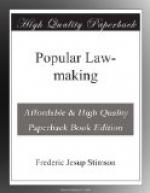These early Anglo-Saxon laws mostly concern only matters of procedure for the courts, or the scale of punishment. As they assume a knowledge of existing law, they are often hard to understand. Here are some of the laws of Wessex:
A.D. 690. WESSEX KING INI.
CAP. 11. “If any
one sell his own countryman, bond or free, though
he be guilty, over sea, let
him pay for him according to his
‘wer.’”
As to “wer.” Now there were slaves in England in those days; at the time of the Conquest the Domesday Book reports twenty-five thousand. Slaves, I mean; not the unfree agricultural laborers, they were in a higher class, but the regularly bound slaves, who were descendants, either of the early British inhabitants or of the Saxons themselves, who had been punished in the courts and had been sentenced into slavery, or men who had voluntarily sold themselves into slavery. For under early Saxon law a man could sell his child into slavery if the child were under seven years old, and above fourteen the child could sell himself. This refers, of course, to that; it is really a kind of predecessor of our Thirteenth Amendment; that is, it forbids slavery; it forbids making new slaves. The word “wer” is the word we have in “wer-wolf,” meaning blood; for instance, “weregild” is a man’s blood money. Every man had a price from the king down; if a man killed the king he had to pay, we will say, fifty thousand pounds; if a thane, it might be one or two thousand; if an ordinary freeman, one hundred pounds, and so on.




